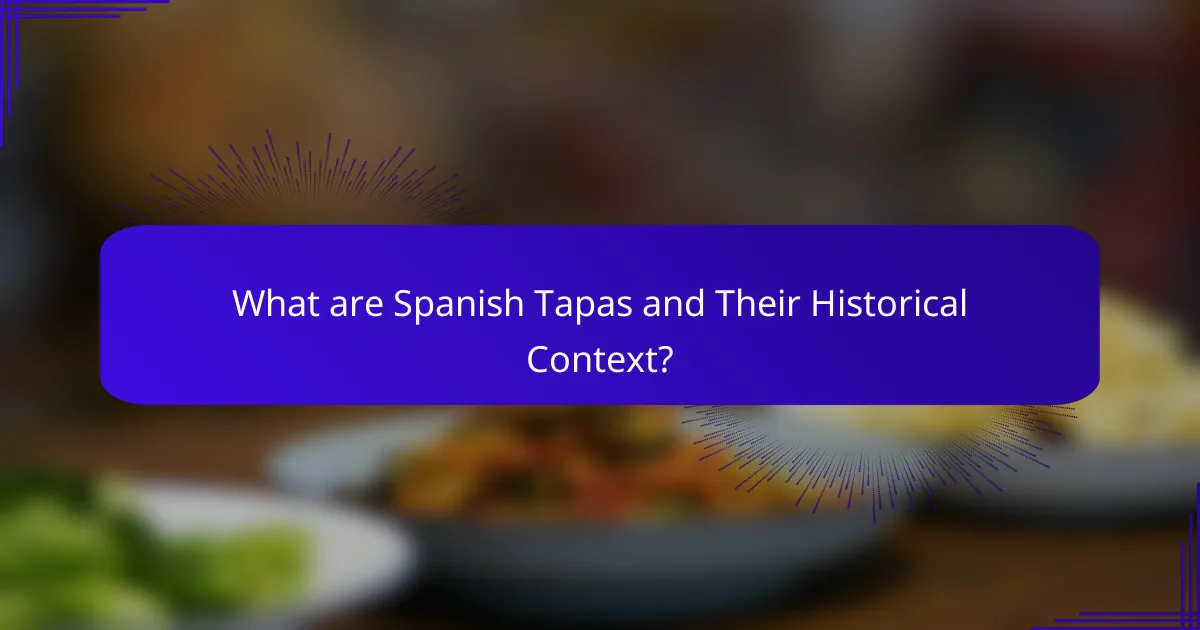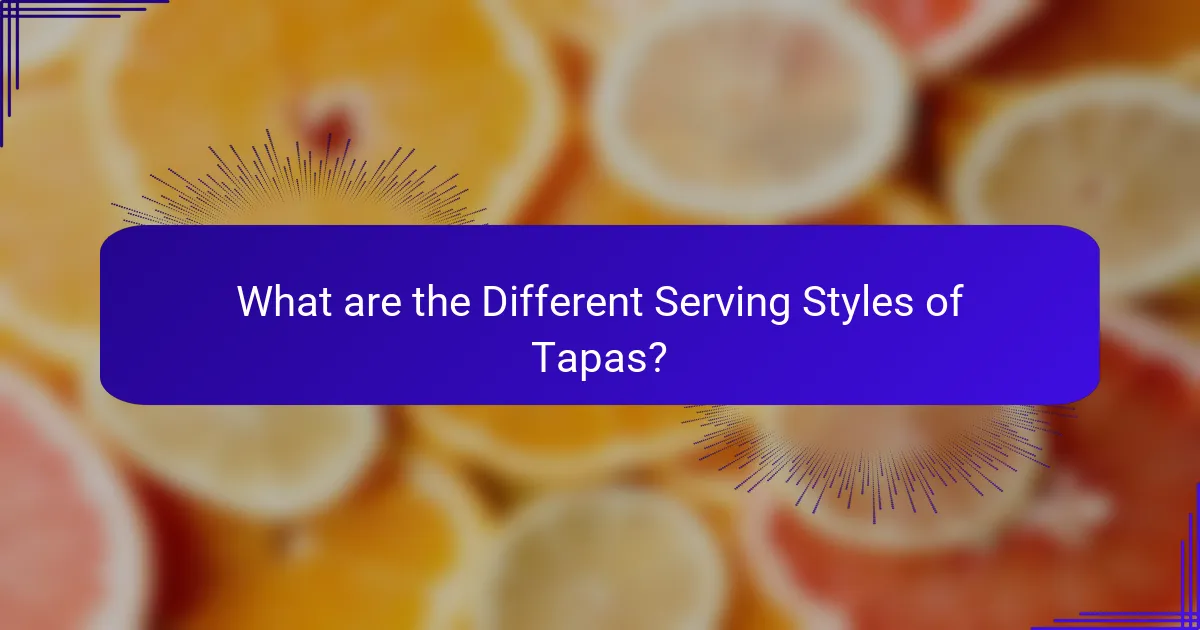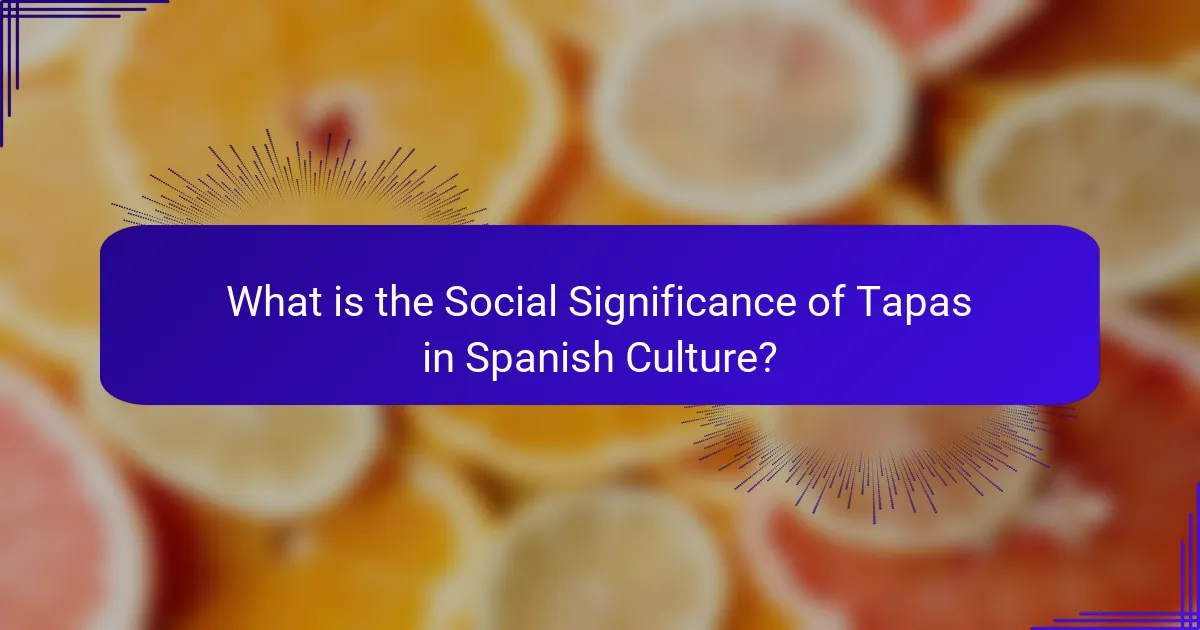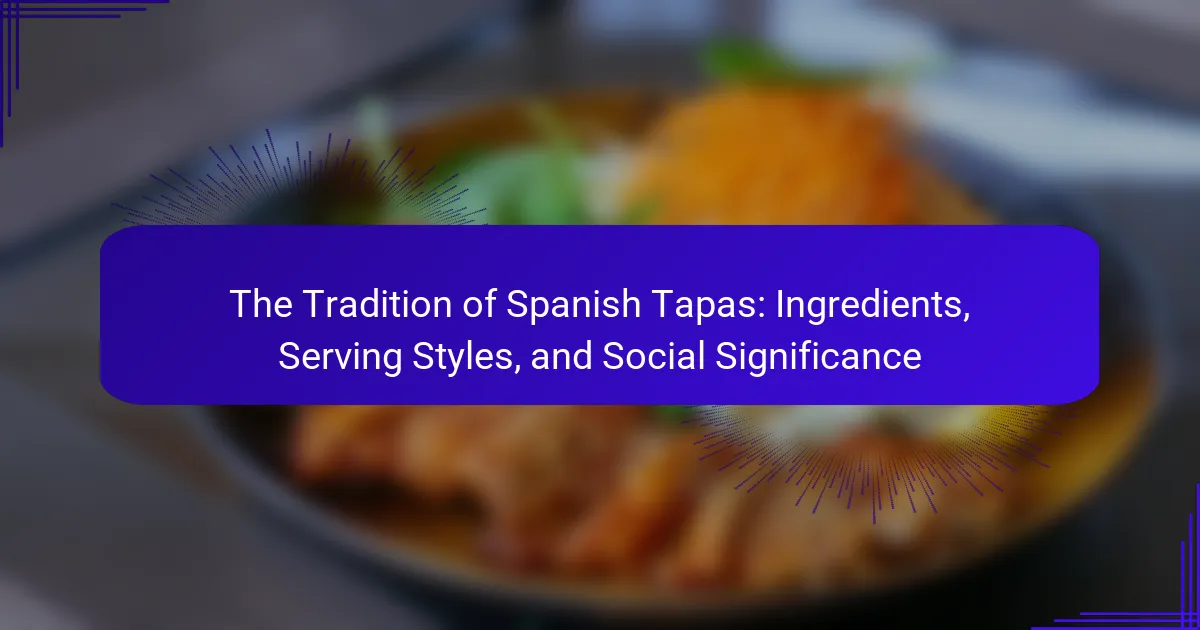
What are Spanish Tapas and Their Historical Context?
Spanish tapas are small dishes or appetizers served in Spain, often enjoyed with drinks. They originated in the 13th century, initially as a way to cover drinks from flies. The word “tapa” means “lid” in Spanish, reflecting this origin. Over time, tapas evolved into a social dining experience. They encourage sharing and conversation among diners. Tapas can include a variety of ingredients, such as olives, cheese, and cured meats. The tradition of tapas is deeply rooted in Spanish culture and varies by region. For example, Andalusian tapas often feature seafood, while those in Catalonia might include bread with tomato. This culinary practice highlights the communal aspect of dining in Spain.
How did the tradition of tapas originate in Spain?
The tradition of tapas originated in Spain as small dishes served alongside drinks. Historically, these small plates were used to cover wine glasses, preventing dust and insects from entering. The word “tapa” translates to “lid” in Spanish, reflecting this practice. Over time, these covers evolved into a culinary tradition of sharing various flavors. Tapas became popular in social settings, encouraging communal dining and conversation. Today, tapas are an integral part of Spanish culture, enjoyed in bars and restaurants across the country. The tradition emphasizes social interaction and a relaxed dining experience.
What historical events influenced the development of tapas?
The development of tapas was influenced by several historical events in Spain. The Spanish Civil War (1936-1939) led to food scarcity, prompting smaller portions to be served. The introduction of the tapa concept is often attributed to the 13th century when King Alfonso X mandated small dishes to accompany drinks. The Moorish occupation (711-1492) also impacted Spanish cuisine, introducing spices and cooking techniques. The rise of social drinking culture in the 19th century further popularized tapas as a way to encourage social interaction. Each of these events contributed to the evolution of tapas into a staple of Spanish culinary tradition.
How has the concept of tapas evolved over time?
The concept of tapas has evolved significantly from its origins. Initially, tapas referred to small plates of food served with drinks in Spain. These small servings were meant to “cover” or “tap” the drink to prevent flies and dust from contaminating it. Over time, tapas became a social dining experience, encouraging sharing and conversation among patrons.
In the 20th century, the variety of tapas expanded beyond simple olives and cheese to include diverse ingredients and flavors. This evolution was influenced by regional culinary traditions across Spain. Today, tapas can range from traditional items to innovative dishes, reflecting contemporary gastronomy.
The rise of tapas bars globally has further popularized this dining style. Tapas now symbolize Spanish culture, emphasizing community and enjoyment. The evolution of tapas illustrates a blend of tradition and modern culinary creativity.
What are the key ingredients commonly used in Spanish tapas?
Key ingredients commonly used in Spanish tapas include olives, chorizo, and cheese. Olives are often marinated in herbs and spices. Chorizo is a flavorful Spanish sausage made from pork. Cheese varieties such as Manchego are frequently served. Other common ingredients include seafood like anchovies and shrimp. Vegetables such as peppers and tomatoes are also popular. Bread, particularly crusty varieties, is typically served alongside. These ingredients reflect the regional diversity of Spanish cuisine.
Which meats are popular in traditional tapas dishes?
Popular meats in traditional tapas dishes include chorizo, jamón, and morcilla. Chorizo is a spicy sausage made from pork and seasoned with paprika. Jamón, particularly Jamón Ibérico, is a high-quality cured ham from Spain. Morcilla is a blood sausage that often contains rice and spices. These meats are integral to Spanish cuisine and are frequently served in small portions for sharing. Their flavors complement a variety of tapas, enhancing the overall dining experience.
What vegetables and legumes are frequently included in tapas?
Common vegetables and legumes included in tapas are olives, peppers, and chickpeas. Olives are often served as a simple appetizer. They come in various varieties, such as green and black. Peppers, particularly roasted red peppers, are frequently featured in tapas dishes. They add flavor and color to the selection. Chickpeas are often used in dishes like hummus or served in salads. These ingredients reflect the Mediterranean diet’s emphasis on fresh produce. The use of these vegetables and legumes enhances the variety and appeal of tapas.
How do cheeses and breads contribute to the tapas experience?
Cheeses and breads are essential components of the tapas experience. They offer a variety of flavors and textures that enhance the overall enjoyment of the meal. Cheeses, such as Manchego or Cabrales, provide rich, savory tastes that complement other tapas. Breads, like crusty baguettes or soft pita, serve as a base for various toppings.
Together, they facilitate sharing, a core aspect of the tapas tradition. The act of combining cheeses and breads with other ingredients fosters social interaction. This communal dining style encourages conversation and connection among diners.
Historically, tapas originated as small snacks served with drinks, often including cheese and bread. Their inclusion in tapas reflects the Mediterranean diet, which values fresh, local ingredients. The combination of these elements contributes to a balanced and satisfying culinary experience.

What are the Different Serving Styles of Tapas?
Tapas can be served in various styles, primarily categorized as “pinchos,” “raciones,” and “tapas.” Pinchos are small snacks typically served on a skewer or toothpick. They are often found in northern Spain and are meant for quick consumption. Raciones are larger portions meant for sharing, ideal for groups. These can include a variety of dishes, allowing for a more extensive tasting experience. Traditional tapas are bite-sized servings that can be enjoyed as appetizers or light meals. They are commonly served in bars and restaurants throughout Spain. Each serving style reflects the social aspect of dining in Spain, promoting sharing and conversation among diners.
How are tapas typically served in Spain?
Tapas are typically served in small portions in Spain. They can be enjoyed hot or cold. Tapas are often shared among diners, promoting a social dining experience. They are usually accompanied by drinks, such as wine or beer. In many establishments, tapas may be served as a complimentary snack with beverages. Some restaurants offer a selection of tapas on a menu for customers to choose from. Traditional tapas include items like olives, cheeses, and cured meats. The serving style encourages conversation and a relaxed atmosphere.
What are the differences between cold and hot tapas?
Cold tapas are served at room temperature or chilled, while hot tapas are served warm or hot. Cold tapas typically include ingredients like cured meats, cheeses, olives, and marinated vegetables. They are often ready to eat and require no cooking. Hot tapas usually consist of cooked items such as patatas bravas, chorizo al vino, or fried calamari. These dishes are prepared and served immediately after cooking. The serving temperature is the primary distinction between the two types. Cold tapas emphasize freshness and simplicity, while hot tapas focus on warmth and comfort.
How do portion sizes vary among different tapas dishes?
Portion sizes among different tapas dishes vary significantly. Tapas can range from small bites to larger shareable plates. For example, a serving of olives or almonds may consist of just a handful. In contrast, a dish like patatas bravas typically comes in a bowl sufficient for sharing. Seafood tapas, such as gambas al ajillo, often have a standard portion that serves two to three people. Furthermore, some dishes like tortilla española can be served in wedges, allowing for customizable portions. Overall, the diversity in portion sizes reflects the variety of tapas styles and dining experiences.
What role do tapas play in Spanish dining culture?
Tapas play a central role in Spanish dining culture as they promote social interaction and communal eating. These small dishes encourage sharing among friends and family, fostering a sense of togetherness. Traditionally, tapas are enjoyed in bars and restaurants, often accompanied by drinks. This practice creates a casual dining atmosphere, allowing diners to sample various flavors. The variety of tapas reflects regional culinary diversity across Spain. Tapas also serve as an appetizer or a light meal, adapting to different dining occasions. The social significance of tapas is evident in their role during celebrations and gatherings, enhancing the overall dining experience.
How do tapas influence social interactions during meals?
Tapas influence social interactions during meals by promoting sharing and conversation. The small, shareable portions encourage diners to engage with each other. This communal dining experience fosters a relaxed atmosphere. People often try multiple dishes, which sparks discussions about flavors and preferences. Tapas dining typically lasts longer than traditional meals. This extended time allows for deeper connections and social bonding. The variety of dishes also invites diverse tastes and preferences, enhancing group dynamics. Overall, tapas create a vibrant social setting that encourages interaction and connection among diners.
What occasions are tapas typically associated with in Spain?
Tapas are typically associated with social gatherings and celebrations in Spain. These small dishes encourage sharing and conversation among friends and family. Tapas are commonly enjoyed during casual outings at bars or restaurants. They also feature prominently during festive occasions, such as holidays and local festivals. In Spain, tapas serve as a way to enhance the dining experience. They are often paired with drinks, creating a lively atmosphere. Sharing tapas fosters community and connection among diners. This tradition reflects Spain’s rich culinary culture and social customs.

What is the Social Significance of Tapas in Spanish Culture?
Tapas hold significant social importance in Spanish culture. They serve as a medium for social interaction and community bonding. Sharing tapas encourages conversation and fosters relationships among friends and family. This practice promotes a sense of belonging and togetherness. Historically, tapas originated as small portions of food served with drinks. They have evolved into a culinary tradition that reflects regional diversity. The act of going out for tapas is often a communal experience. Tapas bars are common social hubs in Spain, enhancing local culture. Overall, tapas symbolize hospitality and the joy of sharing meals in Spanish society.
Why are tapas considered a symbol of Spanish hospitality?
Tapas are considered a symbol of Spanish hospitality because they encourage sharing and social interaction. Traditionally, tapas are small dishes served with drinks, promoting a communal dining experience. This style of eating fosters conversation and connection among guests. In Spain, offering tapas to visitors signifies warmth and generosity. The practice dates back to the 13th century, evolving into a cultural staple. Tapas vary widely, reflecting regional ingredients and culinary traditions. Their diverse nature allows hosts to cater to different tastes and preferences. Overall, tapas embody the Spanish value of enjoying food together, enhancing the sense of community.
How do tapas foster community and connection among diners?
Tapas foster community and connection among diners by promoting shared experiences and social interaction. The small, shareable portions encourage guests to order multiple dishes. This format allows diners to sample a variety of flavors together. Sharing food creates conversation and bonding moments. Tapas dining is often a leisurely experience, encouraging prolonged social engagement. The communal style of eating fosters a sense of togetherness. In Spain, tapas are traditionally enjoyed in social settings, enhancing cultural connections. Studies show that communal dining can strengthen relationships and improve social well-being.
What cultural rituals are associated with sharing tapas?
Sharing tapas is deeply rooted in Spanish culture and involves several rituals. One key ritual is the act of gathering with friends and family at a bar or restaurant. This social setting promotes conversation and connection. Another ritual includes the communal sharing of small plates. Diners often order multiple dishes to share, fostering a sense of togetherness.
The tradition emphasizes leisurely dining. Meals can extend for hours, allowing for relaxed enjoyment of food and company. Additionally, there is a cultural practice of pairing tapas with drinks, such as wine or beer. This enhances the social experience and encourages prolonged interactions.
In regions like Andalusia, the ritual may include specific local dishes. Each region showcases its unique flavors and ingredients. Overall, sharing tapas embodies the Spanish values of community, hospitality, and enjoyment of life.
How can one recreate the tapas experience at home?
To recreate the tapas experience at home, start by preparing a variety of small dishes. Popular tapas include patatas bravas, chorizo, and olives. Use fresh ingredients to enhance flavors. Serve dishes in small portions to encourage sharing. Incorporate a selection of Spanish wines or sangria for authenticity. Create a casual dining atmosphere with communal seating. This style promotes social interaction, mirroring traditional Spanish tapas bars. Historical practices show that tapas originated as snacks served with drinks, emphasizing their role in social gatherings.
What tips are essential for preparing authentic tapas dishes?
Use high-quality ingredients for authentic tapas. Fresh vegetables, quality meats, and local cheeses enhance flavor. Keep the preparation simple and focus on traditional recipes. Classic tapas include patatas bravas, gambas al ajillo, and tortilla española. Serve in small portions to encourage sharing and social interaction. Pair with Spanish wines or sherries for authenticity. Presentation matters; use rustic dishes to reflect Spanish culture. Tapas are often enjoyed in a relaxed environment, promoting conversation.
How can one effectively pair drinks with tapas for an enhanced experience?
To effectively pair drinks with tapas for an enhanced experience, one should consider the flavor profiles of both the drinks and the dishes. For example, light white wines complement seafood tapas, while robust red wines enhance meat-based options. Sparkling wines can refresh the palate between rich bites. Beer, particularly lighter styles, pairs well with fried tapas. Cocktails can offer a creative twist; citrus-based drinks often balance savory flavors. Additionally, regional pairings enhance authenticity; for instance, sherry is traditionally served with tapas in Spain. Matching acidity levels in drinks with the dish can elevate flavors. Overall, thoughtful pairing enhances the dining experience by harmonizing tastes.
The main entity of the article is Spanish tapas, which are small dishes or appetizers traditionally served in Spain, promoting a social dining experience. The article explores the historical context of tapas, tracing their origins to the 13th century and their evolution into a communal dining practice. It details the key ingredients commonly used, various serving styles, and the role of tapas in Spanish culture, highlighting their significance in fostering social interactions and community bonds. Additionally, the article provides insights on how to recreate the tapas experience at home, including tips for preparing authentic dishes and effective drink pairings.
